Transport IN the United Kingdom
1. Overview
2. Railways
4. The Channel Tunnel
5. Roads
6. Transport on water and in air
Fast train running alongside the M1 motorway near Daventry in Northamptonshire, England
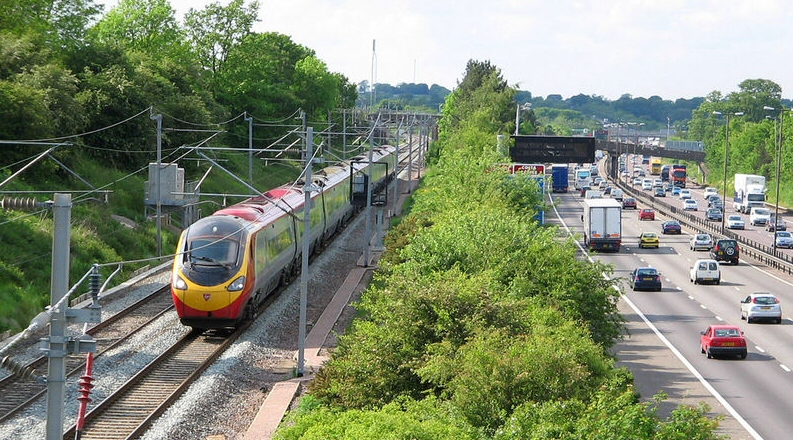
The transport system in the United Kingdom is well developed. A radial
road network of 46,632 km of main roads is centred on London,
Edinburgh and Belfast, whilst, in Great Britain, a motorway network of 3523 km
(![]() 527 km) is centred on both Birmingham and London. There are a further
342,000 km (total: 388,632 km; 0,9% motorway) of paved roads
(
527 km) is centred on both Birmingham and London. There are a further
342,000 km (total: 388,632 km; 0,9% motorway) of paved roads
(![]() 70,050 km, 0,75% motorways).
70,050 km, 0,75% motorways).
The National Rail network of 16,116 route km in Great Britain
(![]() 7,937 km) and 303 route
km in Northern Ireland. Urban rail networks are also well developed in London and several other
cities.
7,937 km) and 303 route
km in Northern Ireland. Urban rail networks are also well developed in London and several other
cities.
Heathrow Airport is the world's busiest international airport, and the UK has a considerable network of ports.
In 2001 detailed funding plans were announced for the first five years of the Government’s ten-year plan, which aims to modernise the UK transport system.
Since 1952 (the earliest date for which comparable figures are available), the UK has seen a dramatic shift away from the use of public transport and towards the use of private transport, for both passengers and freight.
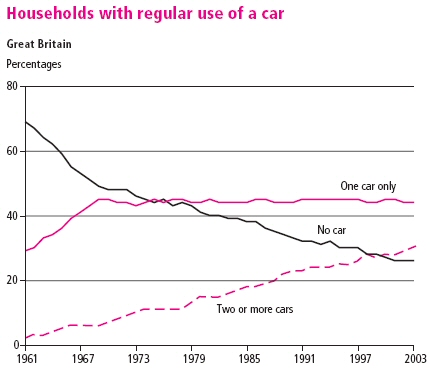
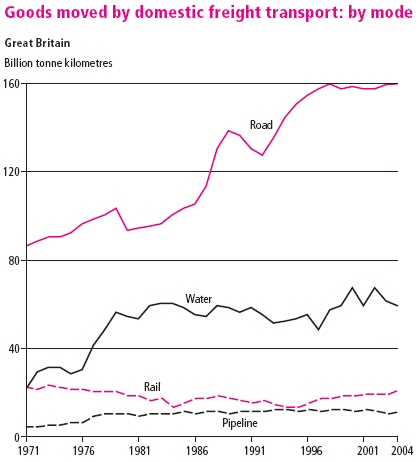
|
Minimum ages for driving are: 16 for riders of mopeds, drivers of small tractors, and disabled people receiving a mobility allowance; 17 for drivers of cars and other passenger vehicles with nine or fewer seats (including that of the driver), small motorcycles, and goods vehicles not over 3.5 tonnes; 18 for goods vehicles weighing over 3.5, but not over 7.5, tonnes; and 21 for passenger-carrying vehicles with more than nine seats, goods vehicles over 7.5 tonnes and large motorcycles. New drivers of motor vehicles must pass both the computer-based touch screen theory test and the practical driving test in order to acquire a full driving licence. |
In 1952 just 27% of distance travelled was by car or taxi; with 42% being by bus or coach and 18% by rail. A further 11% was by bicycle and 3% by motorcycle. The distance travelled by air was negligible. Freight transport has undergone a similar change.
By 2003 85% of distance travelled was by car or taxi; with just 6% being by bus and 6% by rail. Air, pedal cycle and motorcycle accounted for roughly 1% each. This shift from rail to road is both caused by, and a cause of, changes in the relative sizes of their networks; wheareas the rail network has halved from 31,336 km in 1950 to 16,116 km today, the motorway network, which today is 3476 km long, did not exist in 1950. It has also been caused by rising economic affluence, the move of the population away from city centres, and changes in industry.
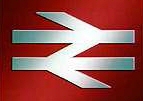
The rail network in the United Kingdom consists of two independent parts, that of Northern Ireland and that of Great Britain. Since 1994, the latter has been connected to mainland Europe via the Channel Tunnel. The network of Northern Ireland is connected to that of the Republic of Ireland.
The rail network in Great Britain is the oldest such network in the world. The world's first intercity railway was the Liverpool and Manchester Railway, designed by George Stephenson and opened by the Prime Minister, the Duke of Wellington on September 15, 1830.
Until 1996 the rail network in Britain, and the passenger and freight services on it, were owned, operated and maintained by British Rail, a government-owned monopoly. In 1994 and 1995 British Rail was split into infrastructure (track, stations), maintenance, rolling stock (engines, cars), passenger and freight companies, which were privatised from 1996 to 1997. Privatisation has proved controversial and the rail network has not yet experienced the full improvements that had been hoped. In Northern Ireland, Northern Ireland Railways (NIR) both owns the infrastructure and operates passenger rail services. The Northern Ireland rail network is one of the few networks in Europe that carries no freight.
|
A rapid transit, underground, subway, elevated, or metro system is a railway system, usually in an urban area, with a high capacity and frequency of service, and grade separation from other traffic. Grade separation means that the traffic on a system does not disrupt the flow of traffic on one another when they cross (e.g. underground, motorway). |
Three cities in the UK have rapid transit systems. Most well known is the London Underground, commonly known as the Tube, the oldest and longest rapid transit system in the world. Also in London is the separate Docklands Light Railway (redeveloped for the Docklands area of east London), though this is integrated with the Underground in many ways. Outside of London there is the Glasgow Subway and the Tyne and Wear Metro (based around Newcastle upon Tyne and Sunderland).
There has been a revival in interest in tram/light rail services, and the Government’s ten-year plan indicates a growing role for tramways, with the provision of up to 25 new lines in major cities.
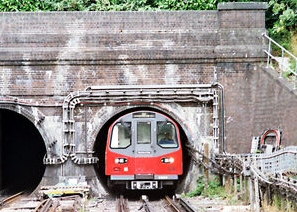
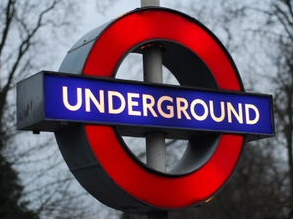 The
London Underground is a metro system that covers Greater London, England, and
some neighbouring areas. It is the oldest underground system
(
The
London Underground is a metro system that covers Greater London, England, and
some neighbouring areas. It is the oldest underground system
(![]() the 2nd oldest is the Budapest Földalatti), and - in terms of
route length - the longest, in the world. Popular local names include the
Underground and the more familiar Tube, the latter describing the
cylindrical shape of the system's deep tunnels. The Underground is an electric railway and
currently serves 275
stations and runs over 408 km of
lines
(
the 2nd oldest is the Budapest Földalatti), and - in terms of
route length - the longest, in the world. Popular local names include the
Underground and the more familiar Tube, the latter describing the
cylindrical shape of the system's deep tunnels. The Underground is an electric railway and
currently serves 275
stations and runs over 408 km of
lines
(![]() 42 stations, 32 km). The Underground does not run 24 hours a day because all track maintenance
must be done at night after the system closes (unlike systems such as the
New York City Subway). The
Underground connects with international Eurostar
trains (crossing the Channel Tunnel) at
Waterloo, and runs to
Heathrow Airport.
42 stations, 32 km). The Underground does not run 24 hours a day because all track maintenance
must be done at night after the system closes (unlike systems such as the
New York City Subway). The
Underground connects with international Eurostar
trains (crossing the Channel Tunnel) at
Waterloo, and runs to
Heathrow Airport.
The 1st zone of the London Underground
Covering the same area as the Budapest Metro: Déli pu. - Keleti pu. and Árpád híd - Népliget
... but bit more dense
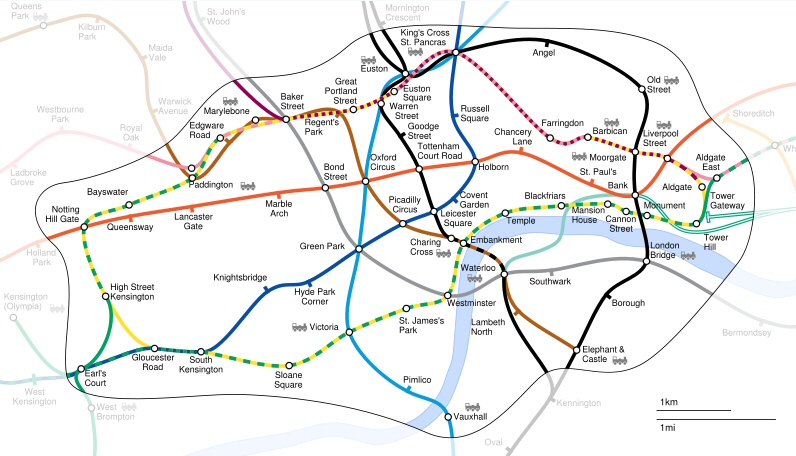
London Underground uses Travelcard zones to calculate fares, including fares for use on the Underground only. Travelcard Zone 1 is the most central, with a boundary just beyond the Circle Line and Travelcard Zone 6 is the most outlying and includes London Heathrow Airport. (All of Greater London is covered by zones 1 to 6, although stations in the outlying reaches of the Metropolitan Line outside Greater London are in the special zones A to D.) There are staffed ticket offices open for limited periods and ticket machines usable at any time. While some machines which sell a limited number of tickets accept only coins, other touch-screen ticket machines will accept coins and English paper money - though not Northern Irish or Scottish notes - in good condition, and usually give change. (These machines also accept major credit and debit cards and some newer machines will accept payment only by card.)
The following tickets are available for use on the Underground:
|
Ticket |
Paper |
Off peak version |
Notes |
|
|---|---|---|---|---|
|
Single |
Yes |
Yes |
Yes (on Oyster) |
Paper tickets are priced at a (much) higher rate. |
|
Day Travelcard |
Yes |
No |
Yes |
The maximum daily spend on Oyster is capped at 50p below the Travelcard price. |
|
3-day Travelcard |
Yes |
No |
Yes |
|
|
Weekly Travelcard |
No |
Yes |
No |
Weekly Travelcards are still available on paper at National Rail stations. |
|
Monthly Travelcard |
No |
Yes |
No |
Requires registration. |
|
Annual Travelcard |
No |
Yes |
No |
Requires registration. |
1 £ ≈ 380 Ft; 2005-2006
| Single fares: |
inside a zone: £1.00 (cash single fare: £3.00) inbetween zone 1 and 6 (1-6): £3.50 (cash single fare: £4.00) |
| Day Travelcards (Peak): |
£6.20
(1 - 2) -
£12.40
(1-6) Can be used all day Mondays to Fridays, on the day of validity and for any journey that starts before 04:30 the following day. On public holidays it is cheaper to buy an Off-Peak Day Travelcard. |
| Day Travelcards (Off-Peak): |
£4.90 (1 - 2) - £6.30 (1-6) Can be used from 09:30 Mondays to Fridays, all day Saturdays, Sundays and public holidays, on the day of validity and for any journey that starts before 04:30 on the following day. |
| 3 Day Travelcards (Peak): | £15.40 (1-2) - £37.20 (1-6) |
| 3 Day Travelcards (Off-Peak): | £18.90 |
Travelling from zone 5 to Victoria Station (zone 1) on our first day in London my husband and I were gearing up to see as much of the city and its culture as possible in the upcoming 2 weeks. Little did we know at the time of boarding our train and being somewhat vexed by the cost and time of our travel that we were out for quite an experience of "culture shock" already 5 minutes into our seemingly waste of time daily trip. First off, as more and more people got on the train we were surprised to see a lot of very smartly dressed professionals, all in their suits riding a train to work. In Hungary these people would normally drive to work in their fancy cars and would definitely not mingle with the average city dweller. The second surprise came when one of them sitting accross from us finished reading his paper and instead of putting it back in his brief case just shoved it under his seat. We glanced over to the next row of seats and could see a similar scene unfold. Our gentleman then proceeded to have his breakfast, taking out an apple together with a drink from his case. (I for one would have been embarrassed to eat and drink when dressed so elegantly and with so many people sitting around me.) Well, he did not seem the least bit bothered, not even when, having finished his drink, with the same gesture as before he casually tossed the container on top of the newspaper underneath and went on eating his apple. We could not mask our utter shock and both of us murmured something in Hungarian to the other like: "Hey, our gentleman in the suit here is really behaving like an authentic homeless person in disguise. If he is going to throw his apple-core down the same as he did with his newspaper and drink, I tell you that I am going to make a remark about it - though I be a foreigner and he an Englishman! It just doesn't make sense." And throw down whatever remained of his apple he did! And nobody appeared to take notice in the entire compartment!! Well, that just made me upset the more, so I decided to break the complicit silence with which everybody was pretending not to notice. "Excuse me, sir. I am fully aware that it is none of my business, but as a foreigner I am really surprised by the fact that obviously well-situated people like yourself would throw your litter bellow your seat instead of disposing them in a litter container or putting them back into your brief case." You can guess that at once everybody in the entire compartment fixed their eyes on us. It was my turn to be embarrassed, but I was in the right so I wasn't going to back out of this. I could sense the uneasiness in my husband as well as in the voice of the gentleman called on to answer. He was kind enough to briefly point out that as long as British Rail did not provide litter containers on her trains he felt authorized to leave his rubbish under his seat. On the way back we found out from someone else that there used to be containers but they had to be removed as part of a safety measure because of repeated incidents of IRA bomb threats... To finish my story, let me add for the sake of fairness that our gentelman's case did not turn out to be an isolated case at all. In fact, many tube cars as well as trains are full of newspapers and other sorts of trash by the time they near their final destination. Obviously all sorts of people "feel authorized" to protest against the IRA and dispose of their litter this way. (I, for one, would not have thought that coming back home I could ever be proud of the cleanliness of our metro and trains. Well, compared to what I have seen in London, I am proud!)
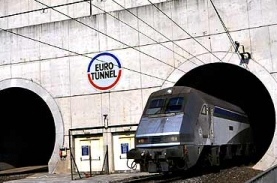 The
Channel Tunnel is a 50 km-long (31 miles) rail tunnel beneath the English
Channel at the Straits of Dover, connecting Cheriton, Kent in the United Kingdom
to Coquelles near Calais in northern France. A link between Great Britain
and continental Europe had been proposed already in 1802 by a French engineer.
The tunnel was officially opened by Queen Elizabeth II and French President
François Mitterrand in a ceremony held in Calais on 6 May 1994. The Channel
Tunnel consists of three parallel tunnels. There are two rail tunnels, measuring
7.6 metres in diameter and about 30 m apart, and a smaller service tunnel
between the two larger one. Digging the tunnel took 15,000 workers over seven
years, with tunnelling operations conducted simultaneously from both ends. In
the Tunnel four types of train services are operated by Eurotunnel:
The
Channel Tunnel is a 50 km-long (31 miles) rail tunnel beneath the English
Channel at the Straits of Dover, connecting Cheriton, Kent in the United Kingdom
to Coquelles near Calais in northern France. A link between Great Britain
and continental Europe had been proposed already in 1802 by a French engineer.
The tunnel was officially opened by Queen Elizabeth II and French President
François Mitterrand in a ceremony held in Calais on 6 May 1994. The Channel
Tunnel consists of three parallel tunnels. There are two rail tunnels, measuring
7.6 metres in diameter and about 30 m apart, and a smaller service tunnel
between the two larger one. Digging the tunnel took 15,000 workers over seven
years, with tunnelling operations conducted simultaneously from both ends. In
the Tunnel four types of train services are operated by Eurotunnel:
-
Eurostar high speed passenger trains. Frequent services connect London (Waterloo) and Paris or Brussels, taking less than 3 hours and 2 hours 40 minutes respectively.
-
Eurotunnel Shuttle passenger shuttle trains. These carry cars, coaches and vans (passengers stay with their vehicles - unlike during travelling on a ferry).
-
Eurotunnel freight shuttle trains. These carry lorries on open rail wagons, with the lorry drivers travelling in a separate passenger coach.
-
Freight trains. These trains carry conventional rail freight or container loads.
Prices start from £49/car one way compared to the ferry starting from £55.
Roads
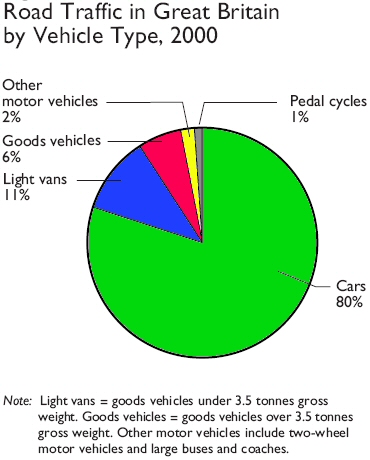 The road
network in the United Kingdom is extensive, with around 370,000 km of road, and the most popular method of transportation. A high-speed
motorway
system, with a total length of 3300 km, was constructed from the 1950s
onwards, and links all major cities. The maximum speed limit is 70
miles per hour (113 km/h). Alongside the motorway system are trunk
roads, many of which are
dual carriageway, various A and B roads, and many unclassified roads. Toll
roads are rare in the United Kingdom, though there are many toll
bridges such as the
Severn crossing connecting England and Wales over the Severn estuary. Although
motorways account for less than 4% of the total road network
they carry over half of all goods vehicle traffic
in Great Britain.
The road
network in the United Kingdom is extensive, with around 370,000 km of road, and the most popular method of transportation. A high-speed
motorway
system, with a total length of 3300 km, was constructed from the 1950s
onwards, and links all major cities. The maximum speed limit is 70
miles per hour (113 km/h). Alongside the motorway system are trunk
roads, many of which are
dual carriageway, various A and B roads, and many unclassified roads. Toll
roads are rare in the United Kingdom, though there are many toll
bridges such as the
Severn crossing connecting England and Wales over the Severn estuary. Although
motorways account for less than 4% of the total road network
they carry over half of all goods vehicle traffic
in Great Britain.
Cars
If you decide to travel to England by car the first obvious difference is that they drive on the "wrong side of the road". Driving on the left-hand side is most difficult when you want to ovetake another car, since you either fully trust the judgement of the person sitting next to you or you have to go over to the opposite lane just to be able to see whether it is OK to overtake. Then there is a countless number of roundabouts which you must not enter or exit as you would in Hungary. Distance on the roadsigns or on the maps is given in miles. Beware, on the same page of a map there might be Northern France and Southern England with the same tiny numbers indicating distance, but in the first case the same number is in kilometers while in the second it is in miles - without any hint. If you happen to calculate distance and time make sure you know that a mile is roughly one and a half times as much as a kilometer. There are surprisingly many speedometers even in small towns to ensure that drivers will keep the speed limit (which is roughly the same as in Hungary). The ringroad around London has 6 lanes, yet in rush-hour traffic it becomes so congested that they fittingly call it the world's largest parking lot.
Coaches and Buses
Coaches - long distance buses or buses used for sightseeing tours
Buses - operated on regular routes and scheduled stops around or between settlements
Coaches, mainly run by National Express provide long-distance links. Scottish Citylink-Megabus operate most coaches within Scotland. Within regional areas, there are various bus systems, that were originally owned by local councils, but have been privatised. Services in Northern Ireland are operated by Translink, a government owned company. Coach services are generally cheaper than travelling by rail, although the journey times are longer and more unpredictable on crowded roads.
London Bus
|
Queueing An English man, even if he is alone, forms an orderly queue of one. George Mikes The British are justly famous for fair play, a form of which is queuing for everything everywhere. The English would simply be scandalized to see the way Hungarians get on the bus, pushing, shoving and elbowing their fellow citizens who have perhaps arrived long before them to the busstop but were not as resolute or "desperate" to aboard the bus as they were. One only queues for a bus in Hungary if its a long distance bus that allows boarding only through the front door. Even then you are more likely to see a shapeless crowd pushing forward than an orderly queue. Beware, "jumping the queue" is a major offense in England. |
Buses have been used on the streets of London since 1829, first pulled by horses. Until the 1950s, London tended to go its own way in terms of bus design (to the left), designing its own vehicles specifically for London use rather than using the bus manufacturers' general products used elsewhere in the UK. Since the turn of the Millennium, there has been a shift to low-floor double-deck (in the middle) and jointed buses (to the right), locally called bendy buses. Local buses within London form a network managed by London Buses, an arm of Transport for London, although most services are operated by private sector operators operating under contract to London Buses.
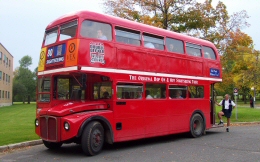
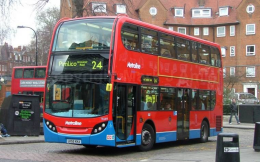
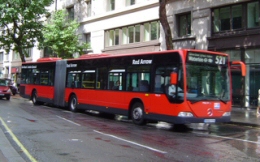
Buses are always boarded from the front (unlike in Hungary where you can get on and off at any door!!!). One way of seeing London's major sights is on an open-top double-decker bus. Tickets are valid for 24 hours and allow unlimited 'hop on/hop off' travel. Night buses are the only public transport that run through the night in the capital. Most parts of London are within easy reach of at least one Night bus service.
Ticket prices are the following:
Peak (Monday to Friday from 07:00 and before 09:30 pm): £1.00 (Oyster) £1.50 (Paper ticket)
Off Peak (All other times including public holidays): £0.80 (Oyster) £1.50 (Paper ticket)
Taxis
taxicab - allowed only to cruise the streets looking for passengers to pick up
minicabs (private hire vehicles) - may only pick up passengers who have previously booked or who visit the taxi operator's office
There are about 61,000 licensed taxis in England and Wales (mainly in urban areas), around 9,000 in Scotland, and about 11,000 in Northern Ireland. In London (which has over 20,000 taxis) and several other major cities, taxis must be purpose-built to conform to strict requirements. In many districts, taxi drivers have to pass a test of their knowledge of the area. You can still see oldfashioned cabs (black taxies) on the streets of London however many new cabs are colorful and many are covered with advertising. These are usually equipped to carry wheel-chairs. They can be hired by simply finding an unbooked one on the street - with the 'TAXI' sign lit up at its top, or by phone. Taxis are quite expensive so British people rarely use them. Most drivers expect a tip of 10-15 per cent of the fee.
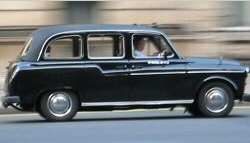
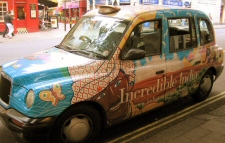
 Inland waterways
(canals) are now used mainly for
leisure and general recreation, but they have
a number of other important roles: as a heritage and environmental
resource, as a catalyst for regeneration, and in land drainage and water supply. Some inland waterways still carry freight.
Inland waterways
(canals) are now used mainly for
leisure and general recreation, but they have
a number of other important roles: as a heritage and environmental
resource, as a catalyst for regeneration, and in land drainage and water supply. Some inland waterways still carry freight.
It is estimated that about 95% by weight (75% by value) of the UK’s foreign trade is carried by sea. The UK fleet has declined considerably in tonnage terms in the last 25 years, reflecting changing trade patterns, usage of the Channel Tunnel, removal of grants, and greater competition. There are still about 70 ports of significance in Great Britain, while several hundred small harbours cater for local cargo, fishing vessels, island ferries or recreation.
British Airways is the world’s largest international airline. British Airways was one of the founders, together with American Airlines, Canadian International Airlines, Cathay Pacific and Qantas, of the ‘Oneworld’ alliance. The alliance now has 31 member airlines and serves 565 scheduled destinations in 133 countries. The British Airways group has a fleet of 340 aircrafts, including seven Concordes.
London Heathrow Airport is the United Kingdom's busiest and best-connected airport. It is the busiest airport in Europe in terms of total passenger traffic, and the third-busiest behind Paris and Frankfurt in terms of plane movements and cargo traffic.
The waiting area at London Heathrow airport's terminal 3, uses a centralized waiting area rather than seats at each gate.

|
Oyster card |
a form of electronic ticketing designed for use on Transport for London and National Rail services within the Greater London area |
learn more:
sources:
100 Questions Answered; Foreign & Commonwealth Office, London
National Statistics, UK 2002, The Official Yearbook of Great Britain and Northern Ireland
Wikipedia - Transport in the United Kingdom
James O'Driscoll: Britain Oxford University Press 1997
credits:
Photo of London Heathrow © Tom Murphy 2005